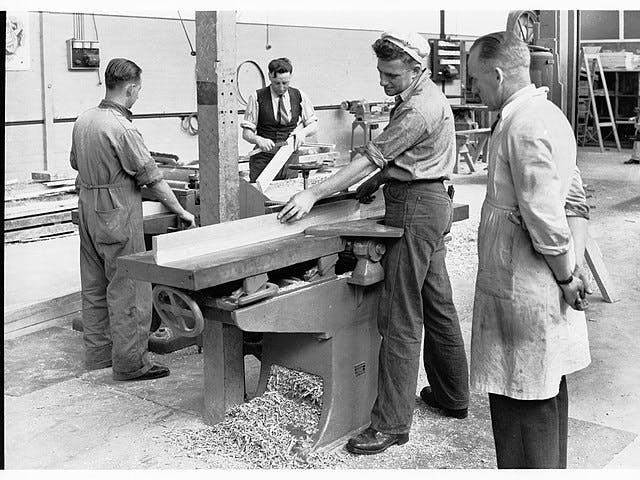Why Community Colleges Should Focus More on Careers
‘My big vision for reforming the higher education system would be to give up the myth that community colleges are a gateway to four-year colleges.’

As community colleges struggle to deliver on their multifaceted missions, it’s time most of them cease preparing students to transfer into bachelor’s degree programs and instead focus solely on providing the best vocational education programs linked tightly to their regional economies.
That’s the view of a former president of Yale University and former chief executive of the online education platform Coursera, Richard Levin.
Mr. Levin has a rare vantage point from which to comment on higher education in America. He’s successfully led two institutions that serve a wide range of students, from the high-flying 18-year-old high school graduate to career-minded adults seeking to upskill and advance.
As hundreds of higher education institutions struggle — Mr. Levin believes that “dozens, maybe even hundreds will close over the next couple of decades or three decades or merge or be absorbed” — part of the reason is that colleges haven’t differentiated themselves or their missions.
As Northeastern’s president, Joseph Aoun, said recently, higher education “is diverse but not differentiated.” Many try to look somewhat like Harvard, only a little less wealthy. That model isn’t working for many students. A more vocational-focused model would benefit them, in Mr. Levin’s view.
He learned this while overseeing Coursera, where demand was high from adults trying to improve their career prospects. The conclusion also stems from Mr. Levin’s time studying the Singapore system of vocational education.
That system is “such an attractive alternative,” Mr. Levin said. “It’s so far superior to our community college system as currently constituted, because it is linked closely with industry. You go to the ITE, Institute of Technical Education in Singapore, and you see state of the art equipment in virtually every trade and profession.”
He added: “You have Marriott Hotels equipping them with an entire mock hotel with every type of facility where they’re training people for the hospitality industry. You see GE Aircraft has put in a whole constellation of equipment so people can work on being aircraft engine mechanics. It’s phenomenal. And the placement rate into jobs after this kind of education is like 93 to 95 percent, whereas our success rate with community colleges, it’s below 50 percent.”
Similarly, Korea in 2010 created “Meister” — meaning master of a trade — high schools. These vocation schools partner with companies in specific industries to create educational experiences tailored to the needs of the workforce. One school, called the Chungbuk Semiconductor High School, was outfitted with cutting-edge semiconductor machinery from a semiconductor company.
There are about 50 such schools today, and after conversion they go from being the shame of the community to prestigious, according to Korea’s former Minister of Education, Science, and Technology, Lee Ju-Ho. The students move from being listless participants in their education to enthusiastic learners, Mr. Lee said. They get “fire in their eyes” as they know they can be the best in something.
Mr. Levin sees this approach as applying to America’s community colleges.
“My big vision for reforming the higher education system would be to give up the myth that community colleges are a gateway to four-year colleges,” Mr. Levin said. “They are for a very small fraction of the students.”
Of those who enter community colleges, for example, 80 percent expect to transfer and earn a bachelor’s degree, yet only 17 percent do within six years, according to the National Student Clearinghouse Research Center. The number transferring has fallen sharply over the past year.
Part of the challenge is that community colleges have three distinct missions that are at odds with each other: academic transfer, career training, and community enrichment.
A focus on academics, for example, causes most community colleges to require a traditional set of general education courses that have arisen out of the academy — like English and math — and offer many degrees that don’t, in the short term, align with the needs of the workforce.
Mr. Levin believes we should convert many community colleges to be solely focused on vocational education “that really links to jobs and gets people launched in careers” — and not necessarily low-skill jobs, as the examples in Singapore show.
This doesn’t mean that community colleges should be the only pathway into vocational education in America. For starters, there’s no guarantee that any given community college can successfully convert itself to focus solely on careers.
Students seem to be already voting with their feet for this focus. According to an education technology writer, Phil Hill, students enrolling in degree programs at two-year colleges fell 29 percent over the past nine years, whereas enrollment in certificate and non-degree programs rose 13 percent.
With the number of adults needing reskilling to keep up with the pace of technological and economic change, community colleges have an opportunity to contribute more concretely to their livelihoods, as well as to the success of many companies and communities. Clarifying their mission by helping students launch and advance in their careers is prudent.

